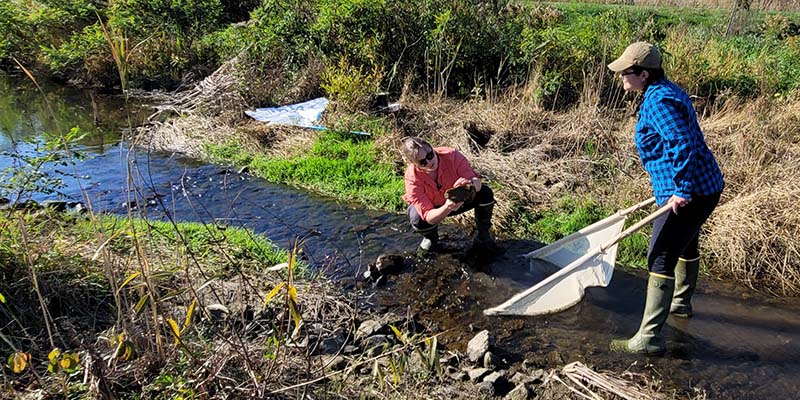
The City of Mentor purchased the 53-acre Springbrook Gardens nursery property in 2015 with the purpose of preserving the open space and creating a predominantly passive-use park. Since that time, a number of improvements have been conducted…and the most important may be the most overlooked.
For the past century, the site had been a commercial nursery and for a century prior, a farm. At some point, the meandering stream that traversed the property was replaced with a deep drainage channel that lacked a natural floodplain and harbored limited habitat features for local wildlife. A great feature for protecting crops from flooding but not ideal for watershed health.
Floodplains, and wetlands in general, improve water quality by removing pollutants from surface waters. By slowing the flow of storm water through the watershed, sediments can collect, and nutrients can be absorbed before they wash downstream and into the lake.
In 2018, the City of Mentor was awarded an Ohio EPA Section 319(h) grant in 2018 to restore the wetlands located at Springbrook Gardens Park. The project, conducted in partnership with Chagrin River Watershed Partners and the Lake County Soil and Water Conservation District, was designed to widen the stream, re-establish a floodplain, and create wetlands with native vegetation and habitat features.
Phase one of the project is substantially complete and presents the first opportunity to measure the water quality of the stream and gauge the success of the restoration.
One way is to measure water quality is by analyzing its chemistry. Measuring the dissolved oxygen, pH, salinity, and temperature provides quality information about the current state of the water in the stream.
But what if we need a long-term picture of a stream’s health? Biological monitoring does just that.
Aquatic macroinvertebrates are insects, crustaceans, mollusks, and worms that spend a portion of their lives underwater and are large enough to see and identify without special equipment like a magnifying glass or microscope.
Different macroinvertebrates have different pollution tolerances and life cycles. For example, Caddisflies are sensitive to pollution. They breathe through their thin, soft, skin and require swiftly moving water to get enough oxygen to survive. Caddisflies also take a few months to a year to emerge from the water as adults, so if water conditions are poor, they will not be found.
Other animals, like crayfish are tolerant of some pollution, but are still sensitive to changes in dissolved oxygen, pH, and food availability. Evidence of pollution-tolerant organisms like leeches and aquatic worms serve are cause for satisfaction. While one might think that finding only pollution-sensitive animals indicates the healthiest streams, in fact the overall goal is biodiversity.
So, what’s next? The City and its partners are preparing for the second phase of the restoration project which will address the upstream section of the stream which flows near Heisley Road.
From waterways and wildlife to trees, invasive species, and parks, the City of Mentor Natural Resources Division is dedicated to the preservation, conservation, study and management of the city’s natural areas. Learn more at www.mentornature.com.
